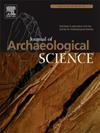Life beyond the lakes: An analysis and implications of a Pleistocene combustion feature on the Pike River in South Australia
IF 2.5
1区 地球科学
Q1 ANTHROPOLOGY
引用次数: 0
Abstract
The Pike River is an anabranch and palaeochannel of the Murray River located in South Australia's Riverland region, in the southwestern part of the Murray-Darling Basin. The floodplain contains abundant and varied archaeological evidence of Aboriginal life, including extensive deposits of shell midden exposed along the high cliff-line bounding the southeastern margin of the floodplain. The oldest of these deposits has been securely dated, so far, to ∼29 ka cal BP. This article presents the results of chronological, micromorphological and sedimentary analyses of a combustion feature also located on this cliff-line. Based on our analysis and interpretation of the feature's stratigraphic context, in combination with 14C and OSL dating, we argue that the feature is ∼43 ka old. Whilst the combustion feature contains no associated cultural material (e.g. stone artefacts or faunal remains) we argue that a cultural origin is, nonetheless, supported given the feature's geometry, sedimentary structures, geochemistry and magnetic response. As such, we argue that the feature provides a rare glimpse into the earliest peopling of the Murray River corridor. Further, the feature is amongst some of the earliest pieces of evidence for human pyrotechnology in the Australasian region and only one of a few examples from an open-air site that is microstratigraphically (micromorphologically) contextualised. The preservation of combustion features of this antiquity in open-context sites is extremely rare, both in this region and globally.
湖泊之外的生命:南澳大利亚派克河更新世燃烧特征的分析与启示
派克河是墨累河的一个分支和古河道,位于南澳大利亚的河地地区,墨累-达令盆地的西南部。泛滥平原包含了丰富多样的土著生活的考古证据,包括在泛滥平原东南边缘的高崖线上暴露的大量贝壳贝壳。到目前为止,这些矿床中最古老的年代已经确定为~ 29 ka cal BP。这篇文章介绍了对同样位于这个悬崖线上的一个燃烧特征的年代、微形态和沉积分析的结果。根据我们对该特征地层背景的分析和解释,结合14C和OSL测年,我们认为该特征的年龄为~ 43 ka。尽管燃烧特征没有包含相关的文化材料(例如石器制品或动物遗骸),但考虑到该特征的几何形状、沉积结构、地球化学和磁响应,我们认为文化起源是支持的。因此,我们认为这一特征提供了对墨累河走廊最早人类的罕见一瞥。此外,这一特征是澳大利亚地区最早的人类烟火证据之一,也是露天遗址中少数几个与微地层(微形态)背景相关联的例子之一。在这个地区和全球范围内,在开放式遗址中保存这种古代燃烧特征是极其罕见的。
本文章由计算机程序翻译,如有差异,请以英文原文为准。
求助全文
约1分钟内获得全文
求助全文
来源期刊

Journal of Archaeological Science
地学-地球科学综合
CiteScore
6.10
自引率
7.10%
发文量
112
审稿时长
49 days
期刊介绍:
The Journal of Archaeological Science is aimed at archaeologists and scientists with particular interests in advancing the development and application of scientific techniques and methodologies to all areas of archaeology. This established monthly journal publishes focus articles, original research papers and major review articles, of wide archaeological significance. The journal provides an international forum for archaeologists and scientists from widely different scientific backgrounds who share a common interest in developing and applying scientific methods to inform major debates through improving the quality and reliability of scientific information derived from archaeological research.
 求助内容:
求助内容: 应助结果提醒方式:
应助结果提醒方式:


